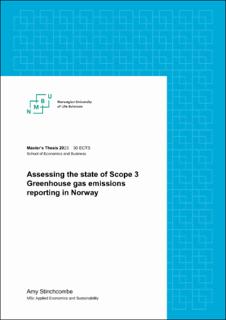| dc.description.abstract | This thesis aims to assess the state of Scope 3 greenhouse gas (GHG) emission reporting in Norway, using data from 2020 to 2022 for the top 100 listed companies as defined by Position Green’s ‘ESG100’ 2022; and which factors explain the variation in reporting among companies. Scope 3 is a company’s indirect emissions related to value chain activity. The state of Scope 3 reporting is important for two reasons, the first being that it will become mandatory for many firms to report Scope 3 emissions for the first time under new CSRD (Corporate Sustainability Reporting Directive) legislation from the EU. Secondly, many firms are facing increasing pressure from stakeholders, including investors, to become more transparent about their impact on the planet and their exposure to climate related risks. As Scope 3 emissions often make up the largest share of a firm’s total carbon footprint, firms that measure them well by mapping out their entire value chain and reporting on material Scope 3 categories can be considered to take a pro-active approach to their climate risk management, especially regulatory risk.
A logistic model was used to assess if firm and industry level variables could predict whether a firm reports on Scope 3 or not. Results suggest several significant variables that increased the odds of a firm reporting on Scope 3 emissions, including firm value and setting a Scope 3 emissions target. One model, also considering industry level effects, was able to correctly predict which firms reported Scope 3 with an accuracy rate of 85%.
A tobit random effects model was used to assess which firm and industry level variables effect the quality of a firm’s Scope 3 performance, measured by a ‘Scope 3 score’. This score gives points to firms based on how many Scope 3 categories they report on, and how many categories deemed ‘material’ to the sector they report on. Results suggest that smaller firms are linked to a higher Scope 3 reporting performance, while newer firms are linked to a lower reporting performance compared with older firms. While the value of the firm significantly increased the odds of a firm reporting, it did not significantly affect the firm’s Scope 3 reporting performance.
The number of companies reporting on Scope 3 emissions increased year on year from 2020 to 2022, as did the average quality of the firms’ Scope 3 reporting. Despite this, the majority of companies have a lot of work to do in terms of improving their Scope 3 reporting if they are to fulfil the requirements of reporting Scope 3 emissions through the lens of ‘double materiality’ that will be required when the CSRD and subsequent ESRS (European Sustainability Reporting Standards) become mandatory. | |
